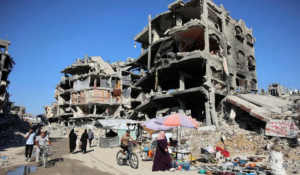How Netanyahu stole defeat from the jaws of victory

People and heavily damaged buildings in a displaced persons camp in Jabalya in the northern Gaza Strip, 15 September 2024
David Hearst writes in Middle East Eye on 7 October 2024:
No commentator on 7 October last year – myself included – would have predicted that the war would still be being fought with the utmost ferocity a year on. No one would have predicted a year ago that Israel would be fighting for longer than it did when it established its state in 1948. All wars Israel has fought since have been brief shows of absolute strength.
Not for want of trying.
Israel has bombed Gaza into the stone age. More than 70 percent of its homes have been damaged or destroyed. Israel is in the process of doing the same to Tyre, the southern suburbs of Beirut and many other parts of southern Lebanon.
No one is raising the white flag. Nor are there significant signs of revolt from a population – now living in tents – that has lost over 41,000 people directly from bombing, and three or four times more in indirect deaths.
The Lancet said the real death toll could exceed 186,000 if other factors, such as disease and lack of healthcare, are taken into consideration. These people are being starved. They are disease-ridden. They are about to face a second winter in tents. They are being bombed daily. And still, they will not submit. This scale of suffering has never been visited on any previous generation.
Every Palestinian alive today knows the stakes. And yet they will not flee. Most would rather die than surrender their land and homes to the occupation.
Two strategies
From the start of this war, there have been two very clear strategies from Israeli Prime Minister Benjamin Netanyahu and Hamas leader Yahya Sinwar.
Netanyahu had four declared objectives in the aftermath of the Hamas attack on southern Israel: to return the hostages; to smash all resistance groups in Palestine and Lebanon; to end Iran’s nuclear programme and weaken its axis of resistance; and to re-order the region, with Israel at the top.
As it quickly became obvious to the families of the hostages, as well as his own negotiating team, Hamas and William Burns, the director of the CIA who oversaw the talks, Netanyahu had no intention of getting the hostages back home. He tried to make Israel believe that pressurising Hamas would ensure a quicker release of hostages. This was patent nonsense, as the vast majority of hostages – there are only 101 still in Gaza – die from the bombs and missiles dropped by Israel. Three were shot dead trying to surrender.
Under Netanyahu’s right-wing government, the lives of the hostages were secondary to the aim of smashing Hamas. Had the hostages returned, Netanyahu could now be facing a long term in prison. But he has demonstrably failed to smash Hamas, hence the speed with which he has started a new war with Lebanon and Hezbollah. Hamas is still in control of Gaza and, until now, and despite two attempts at replacing it as the government of the Strip, no other credible force in Gaza has emerged. Hamas re-emerges wherever Israeli troops are not. Plain clothes police officers emerge to settle disputes within a matter of hours.
At first, Israel tried to wipe out Hamas’s leadership. It has killed the first and second ranks of officials running the government, most of them in a massacre outside al-Shifa hospital. But an insight into what is actually going on in Gaza was offered by Israel’s latest announcement that it had killed three senior Hamas officials – Rawhi Mushtaha, the head of government and de facto prime minister; Sameh al-Siraj, who held the security portfolio on Hamas’s political bureau; and Sami Oudeh, commander of Hamas’s General Security Mechanism.
The air strike happened three months ago, and no one had noticed their absence. This is because Hamas continued to function regardless of which leaders were alive or dead. In the past, assassinations had led to a period of uncertainty for Hamas. This happened after the killing of Abdel Aziz al-Rantisi in 2004. But it does not work today and nor does it work with this generation of fighters.
Decapitation is strictly tactical, and short-term. It provides the killers with temporary relief. Hezbollah’s leadership has indeed been knocked sideways by a series of intelligence coups, starting with the explosion of thousands of booby-trapped pagers and walkie-talkies. But it has not been incapacitated as a fighting force, as the reconnaissance unit of the Golani Brigade is finding out.
